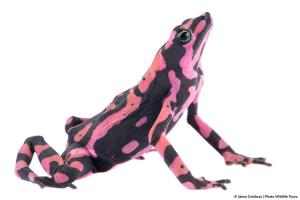
While frog and salamander declines worldwide have made scientists outspoken about the need to preserve amphibian genetic diversity, two University of California, Berkeley, biologists emphasize another important reason for conserving these animals: their poisons.
In a recent review of an endangered group — the colorful, yet poisonous, harlequin toads of Central and South America — Rebecca Tarvin and Kannon Pearson emphasize how little is known about the toxins these animals produce or sequester, or why they have them at all. Yet, of the 113 known species of harlequin toads, most are in decline, and a quarter may already be extinct.